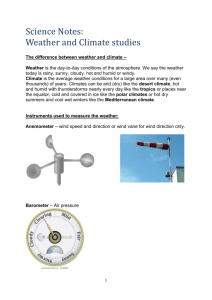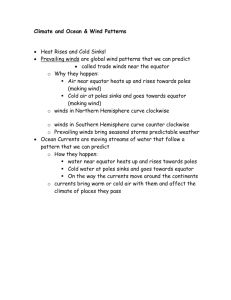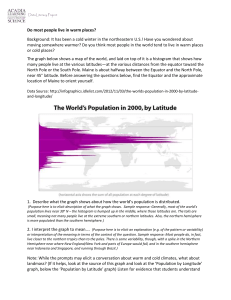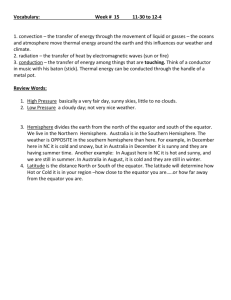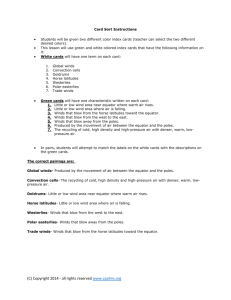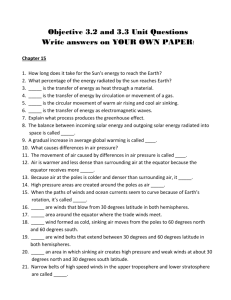Environmental Science Name: Atmosphere and Climate Goal: The
advertisement
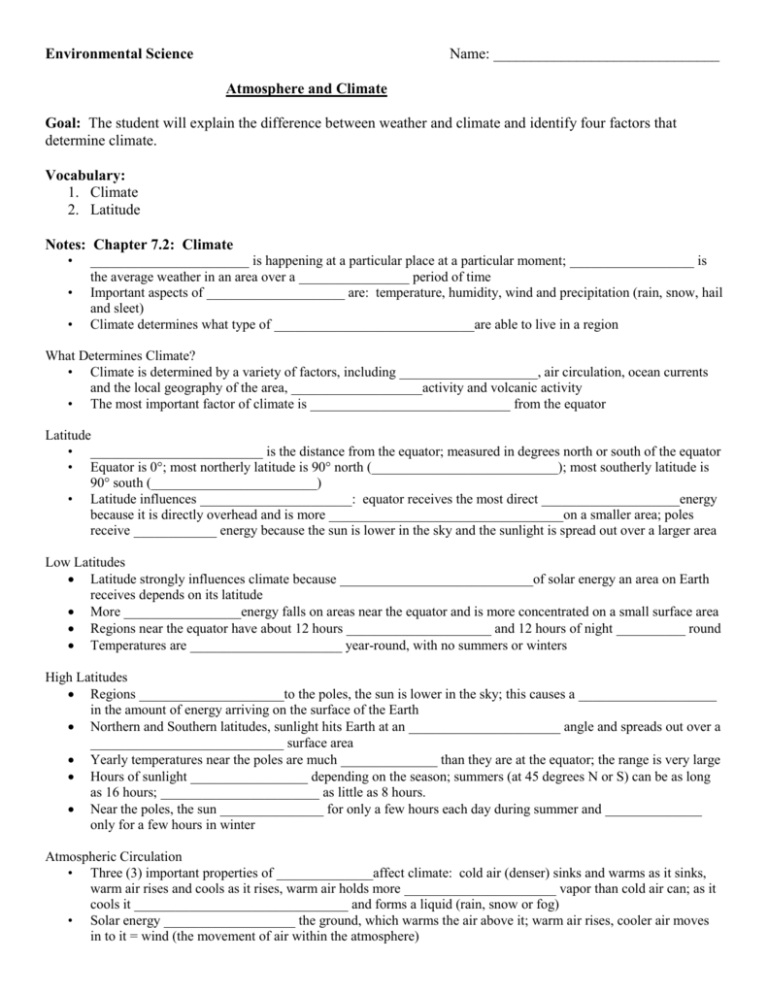
Environmental Science Name: ______________________________ Atmosphere and Climate Goal: The student will explain the difference between weather and climate and identify four factors that determine climate. Vocabulary: 1. Climate 2. Latitude Notes: Chapter 7.2: Climate • • • _______________________ is happening at a particular place at a particular moment; __________________ is the average weather in an area over a ________________ period of time Important aspects of ____________________ are: temperature, humidity, wind and precipitation (rain, snow, hail and sleet) Climate determines what type of _____________________________are able to live in a region What Determines Climate? • Climate is determined by a variety of factors, including ____________________, air circulation, ocean currents and the local geography of the area, ___________________activity and volcanic activity • The most important factor of climate is _____________________________ from the equator Latitude • _________________________ is the distance from the equator; measured in degrees north or south of the equator • Equator is 0°; most northerly latitude is 90° north (___________________________); most southerly latitude is 90° south (________________________) • Latitude influences ______________________: equator receives the most direct ____________________energy because it is directly overhead and is more __________________________________on a smaller area; poles receive ____________ energy because the sun is lower in the sky and the sunlight is spread out over a larger area Low Latitudes Latitude strongly influences climate because ____________________________of solar energy an area on Earth receives depends on its latitude More _________________energy falls on areas near the equator and is more concentrated on a small surface area Regions near the equator have about 12 hours _____________________ and 12 hours of night __________ round Temperatures are ______________________ year-round, with no summers or winters High Latitudes Regions _____________________to the poles, the sun is lower in the sky; this causes a ____________________ in the amount of energy arriving on the surface of the Earth Northern and Southern latitudes, sunlight hits Earth at an ______________________ angle and spreads out over a ____________________________ surface area Yearly temperatures near the poles are much ______________ than they are at the equator; the range is very large Hours of sunlight _________________ depending on the season; summers (at 45 degrees N or S) can be as long as 16 hours; _______________________ as little as 8 hours. Near the poles, the sun _______________ for only a few hours each day during summer and ______________ only for a few hours in winter Atmospheric Circulation • Three (3) important properties of ______________affect climate: cold air (denser) sinks and warms as it sinks, warm air rises and cools as it rises, warm air holds more ______________________ vapor than cold air can; as it cools it _______________________________ and forms a liquid (rain, snow or fog) • Solar energy ___________________ the ground, which warms the air above it; warm air rises, cooler air moves in to it = wind (the movement of air within the atmosphere) • • With _______________________________ latitudes getting different amounts of solar energy results in global circulation which, in turn, determines the amount of ________________________________ at different latitudes Equator (0°) gets __________________ rain (450 cm per year or 177 inches); at 30° north and south are generally warm and ______________________ (most deserts found here); at 60° winds are beginning to rise again and drop again around 90° causing very cold deserts Global Circulation Patterns Cool air normally ________________________, but cool air over the equator cannot descend because hot air is rising below the cool air Cool air is then forced _________________________ from the equator toward the poles At 30 degrees north latitude and 30 degrees south latitude, air accumulates in the __________________ atmosphere; some air __________________ back to Earth’s surface (gradually getting warmer) which moves across the surface, causing water to evaporate from the land, creating ____________conditions Air ascending at 30 degrees north and 30 degrees south latitude move ____________________ the equator or flow to the poles, air moving toward poles ___________________ while near the surface; at 60 degrees north and south latitude, the air _______________________ with cold air traveling from the poles; the warm air _____________, reaching the top of the troposphere, where a small part ______________________ back into the circulation pattern between 60 degrees and 30 degrees north and south latitude. However, most of this uplifted air is forced toward the ____________________. Prevailing Winds Winds that blow predominantly in ______________direction throughout the year are called prevailing winds Because of rotation of the Earth, they do not blow directly north or south but to the _________________ in the Northern Hemisphere and to the ______________________ in the Southern Hemisphere Primarily produced between 30 degrees north and south latitude and the equator; these belts of winds are called _______________________ winds; blow from northeast in the Northern Hemisphere; blow from the southeast in the Southern Hemisphere Prevailing winds known as ______________________________ are produced between 30 and 60 degrees north and south latitude; in Northern Hemisphere these westerlies are southwest winds; in Southern Hemisphere they are northwest winds _________________________ easterlies blow from the poles to 60 degrees north and south latitude Lesson Reflection: Use the diagram of the Earth to mark the direction of the winds based on the information given in your notes. Be sure to label them. Assessment: 1. Explain the difference between weather and climate. 2. Name four factors that determine climate. 3. Explain why different parts of the Earth have different climates. Lesson Extension (Technology/Application/Connection to Real World): Use Battleship game to reinforce latitude and longitude.


